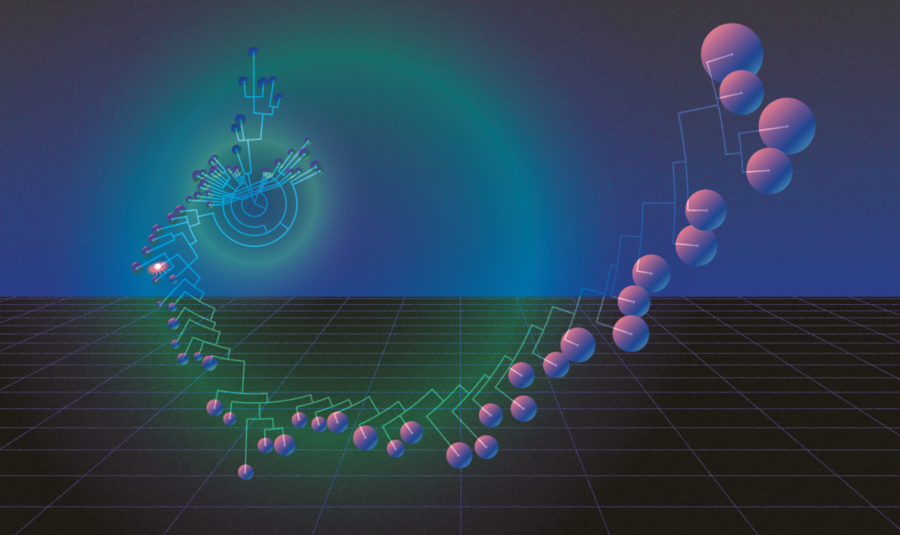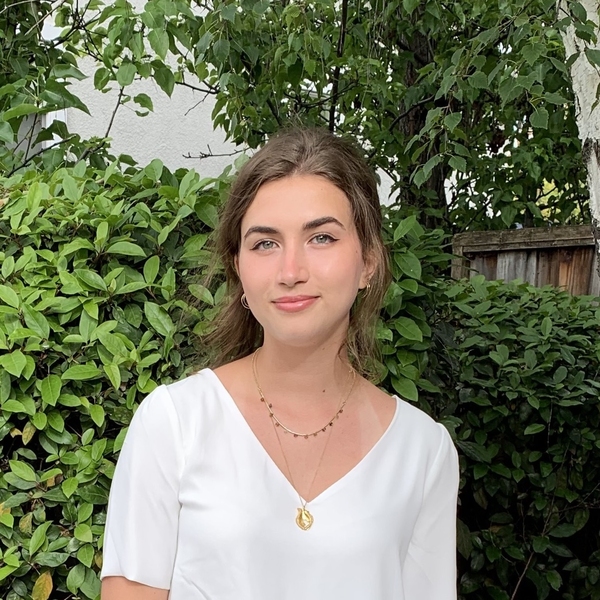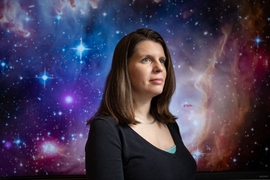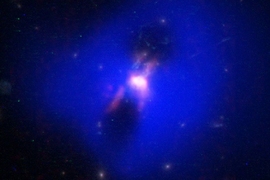Holly Jackson doesn’t think of herself as an astronomer, but her work has contributed to some of the most startling and original research in the field this century. A junior majoring in electrical engineering and computer science, Jackson has become a valued member of Professor Paula Jofré’s research team in the astronomy department at Diego Portales University in Santiago, Chile.
As a participant in MISTI, MIT’s international internship program, Jackson traveled to Santiago in 2019, well before the Covid-19 pandemic shut down in-person international exchanges worldwide. Since then, she has been working remotely from her Cambridge, Massachusetts, apartment with the Chilean astronomy team and biologists in the United Kingdom to build “family trees” of stars in the Milky Way. Here, Jackson discusses her recent work.
Q: Many people are probably familiar with the term evolution in biology, but you’re applying it to the cosmos. How can stellar populations “evolve”?
A: I’m no astronomer, so I had to have this explained to me at the beginning of this project! Essentially, every single star that exists in the universe today (as long as it is not actively exploding) is a blueprint of the chemistry of the specific part of the galaxy where that star was born, at the time of its birth. So basically, you have the Big Bang, which created the lightest elements like hydrogen and helium, and this led to the formation of the first stars. When these first stars died, they donated their processed chemical material back to into galaxies to be recycled into the next waves of star formation. Over the span of gigayears, you begin to see stars containing incremental increases in most of the elements as this process continues.
Essentially, each star is like a fossil of the exact chemical makeup and range of elements available at the time of its birth, and so chemical evolution as a field of study has existed in astronomy for some time now. The process, up until now, has been focused on classifying stars according to their chemical patterns which, in principle, allows us to find stars that are chemically similar and trace them back to their birthplaces if we have their ages and kinematic data. And often astronomers find themselves caught up in uncertainties in the ages, chemical makeup, and kinematics of the stars, hindering the definition of evolutionary relationships. No one had ever made the link to concepts in biological evolution like DNA or parental genealogy before, which introduces a new of class methods to help overcome these challenges.
Q: But that’s changing, thanks in part to the research you’re working on with Paula Jofré to show the “family trees” of stars.
A: In classical astrophysics, there are two methods of tracing stellar origin — the first one, which I talked about, is comparing chemical abundances. If two stars have really similar chemistries, it’s likely they were born in the same gas cloud around the same time. But when they have different chemistries, it gets really difficult to trace their origins. That’s where the second method, stellar kinematics, comes in: tracking the trajectory of a star to figure out where it came from. But all the values which you use in these methods have massive uncertainties; you can back-propagate the values and realize that “Oh no, all the stars I’m comparing could have come from the same place.”
So instead, we’ve been using stellar chemistry as DNA, and treating the information in the same way that evolutionary biologists did through phylogenetics: in other words, we’re sketching out evolutionary trees.
Q: One of the key characteristics of the objects you’re studying is that they are very, very, very far away. How do you get around the vast distances involved and learn the makeup of these stars?
A: Right now, the amount of data on the chemical abundances of stars is in a huge boom, thanks to the European space mission Gaia, a cooperation that has motivated the creation of several ground-based spectroscopic surveys of thousands to millions of stellar data in a very short time. It’s analogous to the Genbank collection, an explosion of data availability in genetics research.
So we have all this data, but it doesn’t necessarily reconcile this fact that DNA and elemental abundances are entirely different measurements. That’s where an interesting component of our project comes in and where we encounter a lot of skepticism: we are dealing with 30 different decimal abundance measurements with lots of room for error, but DNA is just four letters. Evolutionary biologists told us something very cool about when the field of evolutionary biology was just starting and they were dealing with similar issues; they would measure traits in terms of continuous decimal measurements, and those measurements, because they were highly subjective, produced data with a lot of errors. For instance, we can imagine early evolutionary biologists trying to track the evolution of dog breeds by measuring their leg lengths; you can just imagine all the different ways that two people could measure a bunch of different dogs’ legs and arrive at some very messy data. But, surprisingly, that doesn’t mean that the biologists’ initial trees didn’t have meaning, or weren’t influential in terms of creating models that worked.
We are in a very similar starting point to those early biologists. We have now access to this high-quality data complementary to the Gaia mission, and the evo-bio methods we have been using to analyze that data have been specifically fitted to the astrophysics framework. We’ve honed in on which specific techniques have the most parallels within astronomy, and that work is what’s making these methods super-effective in tracing stellar evolution.
Q: Since, as you said, so much of stellar data is subject to a lot of uncertainty, how can you verify your theory when it’s applied to any given star? Put another way: how do you know you’re right?
A: There are several ways. First off, there is one star we know a lot about: our own sun! The sun is super-useful as a reference point, and our data about the sun is the highest-quality chemical abundance data we can get. So we use a dataset of “solar twins,” stars which have similar properties to the sun, which gives us an advantage and a known set of data.
Additionally, we’ve taken verification methods from biology, such as a stability analysis, which can be performed on evolutionary trees to see how strong the various relationships are. We’ve taken a tree of 79 stars very close to the sun (including the sun itself), analyzed the relationships the tree produced, and then linked them to popular astrophysical theories. And it worked: Not only does the timeline match up, but the structure of the tree matches up as well. We found links between the structure of our tree and a rapid period of stellar evolution after the Gaia-Enceladus Sausage merger. We also related our tree to evidence that the Sagittarius galaxy collided with the Milky Way at a certain point.
Remember: Our tree was produced using no methods from astronomy. It was produced using these methods from biology, and yet it is producing results consistent with current astronomical findings.
Q: Tell me about some of the challenges of this research, especially given the Covid-19 pandemic.
A: One good thing is that we were always very well-equipped to handle remote communication. All the evolutionary biologists involved in the project are in the UK; the astronomers are in Santiago, Chile; and I’m in the U.S. However, the pandemic has presented challenges, as has the political unrest in Santiago, which led to the temporary shutdown of our main astronomer, Paula Jofré’s, university. So everyone is working from home; two team members have young kids, and of course it’s been seriously crazy, but thankfully everyone is super sweet and understanding. All of us are doing this work as our secondary commitment, but that makes everyone more understanding of the challenges. This work would’ve been released a lot earlier without the pandemic, but we’ve been powering through nonetheless.
Q: What skills have you learned as a result of working with Paula Jofré — how has this experience made you a better scientist?
A: I knew nothing about astronomy before starting this project, so this was my first exposure. Paula is an incredibly clear and creative explainer, and presents these concepts in an incredibly intuitive way. The fearlessness with which she approaches her projects has inspired the way I want to work in the future. She has no fear of interdisciplinary research or how her work will be received. She has received a lot of clapback — astronomy can be a very traditional field, and she was also a female physicist presenting this brazen new work that takes theories of biology and applies it to astronomy. And guess what? That work has become super influential, and her 2017 paper got her named in the Time 100 NEXT. She’s just an awesome person, and on top of that such a skilled researcher that she can explain astrophysics to an engineer in just a few weeks; it’s just incredible. Keep an eye out for her upcoming release of her book, which tells the story of the history of the Milky Way intertwined with the inspiring stories of female scientists!
Q: What questions does your research bring up that you’d like to tackle next?
A: On one hand, this work is challenging people because it’s validating a new way to study galactic chemical evolution. There’s a lot of potential for combining techniques and also developing this technique further; we’re not presenting it as a substitution to current methods, because the current methods work. But this new method can be combined with the old methods. For example, people will run chemical simulations and try to reproduce the evolution of the Milky Way and get nowhere close, but if we combine chemical simulations with phylogenetic techniques, we could have potential to reveal more than either of these methods alone.
In addition, we’re using some of the simplest methods in phylogenetics right now, but there’s some crazy stuff in evolutionary biology, including a probabilistic model where you input a lot of data about how you think an evolutionary system behaves. We could use the gold standard methods of astronomy and the gold standard methods of biology to create a really convincing map of the galaxy’s relationships, and I’m really excited about that.
We’ve just posted the preprint, and my inbox is freaking out — the responses are coming not just from astronomers, but people in other fields who are excited about this interdisciplinary field. An astronomer reading this paper is going to have a very different opinion than a biologist reading this paper, but both of their opinions are going to help refine and improve this method. Whenever you can work with two fields you don’t see together too often, that is where the coolest research comes from.










